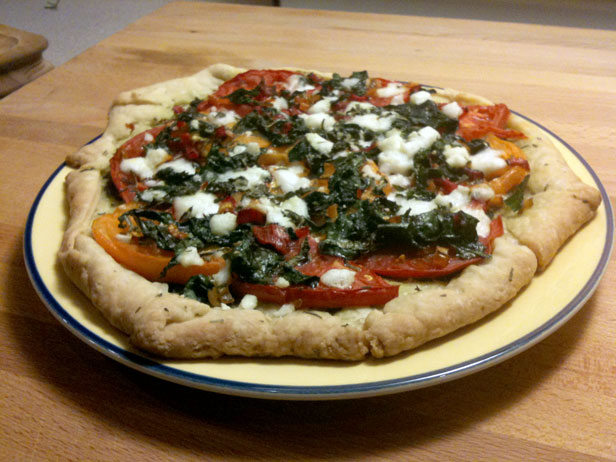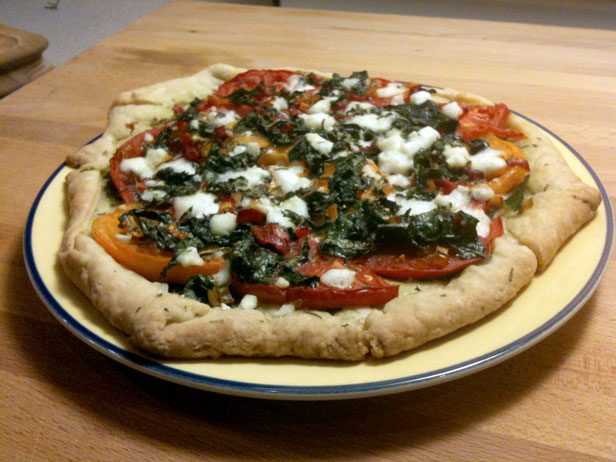 Tart me up: Start with a basic homemade pie crust and anything will taste good.Photos: Bonnie Powell
Tart me up: Start with a basic homemade pie crust and anything will taste good.Photos: Bonnie Powell
Like my colleague Tom Philpott, I believe that cooking “from scratch” doesn’t have to be either intimidating or onerous. Tom is a much better cook than I am, but I’m not going to let that stop me from sharing some of the simple meals I make from local, seasonal ingredients in this Everyday Ethicurean series.
I’m lucky enough to live in Northern California, so 90 percent of what I eat comes from local farms or the raised beds in my backyard. But like this guy, I am no locavore saint. I also buy California produce from the supermarket, because I have a full-time job, two part-time jobs, a baby, and a pretty restricted household budget. In this column, I’ll show you how I go about feeding myself well despite my limited time and money (and skills).
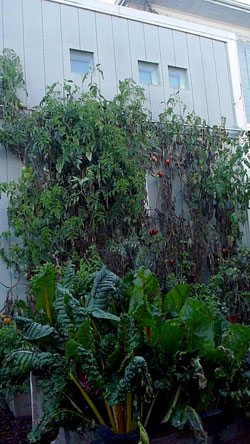 The tomatoes are still goingHalf the battle about cooking, I’ve found, is mental. Instead of starting with some complicated recipe and buying all the ingredients for it, like I used to, I now decide what to make based on whatever is threatening to rot in my fridge or my garden. If I need inspiration, I’ll then look up whatever it is in the index of my two trusty Mark Bittman cookbooks (How to Cook Everything — which is now available as a terrific iPhone app, only $5 — and The Best Recipes in the World, which has lots of unusual dishes that would never occur to me), one of the other 30 or so cookbooks I own, or the couple of food blogs I like and trust. I tend not to just Google “X and recipe” — I’ve been burned too many times on mis-typed ingredients.
The tomatoes are still goingHalf the battle about cooking, I’ve found, is mental. Instead of starting with some complicated recipe and buying all the ingredients for it, like I used to, I now decide what to make based on whatever is threatening to rot in my fridge or my garden. If I need inspiration, I’ll then look up whatever it is in the index of my two trusty Mark Bittman cookbooks (How to Cook Everything — which is now available as a terrific iPhone app, only $5 — and The Best Recipes in the World, which has lots of unusual dishes that would never occur to me), one of the other 30 or so cookbooks I own, or the couple of food blogs I like and trust. I tend not to just Google “X and recipe” — I’ve been burned too many times on mis-typed ingredients.
Right now I have a thriving bed of Swiss chard and a glut of backyard tomatoes. Yes, in November. That’s because I didn’t get around to planting them until May, because of the aforementioned baby. I got a few in early September and then a whole bunch of green ones sat there on the vines (I trellised them) until someone told me to stop watering them. It worked: in late October, they finally turned red. Alas, they’re not great tomatoes. The big heirloom Brandywines are pretty flavorful, but the others are mostly mealy. Still, they’re mine, and they’re free, compared with $3.50 to $4 per pound for the organic tomatoes at the farmers market all summer. I’ve already canned some, made sauce with others, and eaten a lot of tomato sandwiches.
Using what you have, frugally, also means putting stuff by. This summer I grew a lot of basil and other herbs, so I made a lot of pesto — both a straight basil one, and a parsley and sage one, using walnuts, which are local and way cheaper than pine nuts. Stored in the fridge in jars with a layer of oil on top, or frozen in ice cubes, pesto is great for quick pastas or sauces for chicken and fish. The 10 minutes you spend washing the herbs, drying them, and combining with garlic, oil, salt, and nuts will be more than repaid later in time saved. And growing herbs is easy and way cheaper than buying them, especially when you only need a teaspoon here and there.
Wednesday I was having a friend over for dinner, so I wanted to do something a little fancy. I’d been intending to try this “Savory Sweet Potato and Poblano Rustic Tart” that April McGreger wrote about for Grist, so I’d already made and frozen some pie crusts. Using Bittman’s recipe and the food processor, it takes all of five minutes, but if you make them ahead, you can just defrost in the fridge in the morning and be ready to go by dinner.
The result was this “Rustic Tomato and Chard Tart,” which I served with Tom Philpott’s “Butternut Squash Soup with Sautéed Greens.” (What makes a tart “rustic”? The freeform shape — no futzing with pie pans.)
You can make one with just about any fall/winter vegetable and cheese combination, and it will be delicious. As my friend said, “You could put an old shoe on this pie crust, and I would eat it.”
Share your concoctions in the comments to inspire me, please!
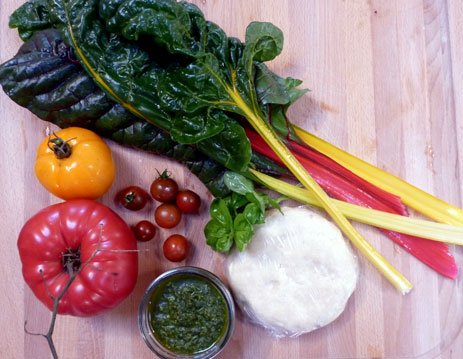 Rustic Tomato and Chard Tart
Rustic Tomato and Chard Tart
Serves two greedy people as an entrée or four as an appetizer
1 flaky pie crust, uncooked (I like this easy Mark Bittman recipe)
Two medium-size tomatoes, sliced
Four or five large leaves of Swiss chard (spinach would be good, too)
About one-fourth cup of feta cheese, crumbled
1 clove garlic, diced
1 tablespoon chopped fresh rosemary or other savory herb (dried is OK)
1 tablespoon olive oil
1 or 2 tablespoons basil pesto (or any other herb)
Splash white wine vinegar
Flour for rolling out crust
Salt to taste
Basil for garnish, cut into ribbons
Preheat oven to 400. Line a pizza pan or cookie sheet with parchment paper. Dust a cutting board or counter top with the flour, then sprinkle half the rosemary (or whatever herb you’re using) in the flour.
Make sure the pie crust is thawed but still cold, then roll it out into rough circle, incorporating the herb as you go. Carefully transfer to the parchment-lined pan, fold the edges over and press (to contain any juices), then prick with a fork. Pre-bake the naked pie crust for 10 to 15 minutes, or until it’s starting to turn golden. (If you’re making the tart with less watery vegetables or some that need to be cooked, you could skip the pre-baking.)
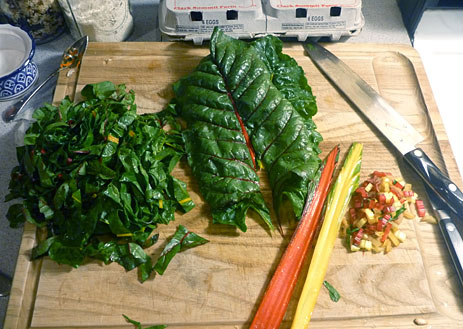 While it’s baking, cut out the stems from the chard, reserving a few to dice for color and crunch. Slice the leaves into ribbons. Heat the oil and garlic and sauté the stems for a minute or two, then the leaves just enough to wilt them. Splash with a touch of vinegar and salt to taste. Since I was also making Tom’s Squash Soup with Sauteed Greens, I cooked enough chard to go in there as well.
While it’s baking, cut out the stems from the chard, reserving a few to dice for color and crunch. Slice the leaves into ribbons. Heat the oil and garlic and sauté the stems for a minute or two, then the leaves just enough to wilt them. Splash with a touch of vinegar and salt to taste. Since I was also making Tom’s Squash Soup with Sauteed Greens, I cooked enough chard to go in there as well.
Remove half-cooked tart from oven. Spread with pesto, arrange sliced tomatoes, and sprinkle with salt. Top with chard, feta, remaining rosemary, and a little olive oil. (I use a fork to spatter it on.) Bake for another 15-20 minutes or until crust is deep golden brown. Sprinkle with fresh basil and serve warm.
